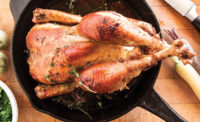Beef, pork, chicken and turkey have, thanks to their widespread availability, become mainstream proteins, taking up the vast majority of a retailer’s meat case or a restaurant’s menu. Everything else gets lumped into the category of “exotic” or “game” meats. That’s not necessarily a fair or accurate description, however.
Consider the case of bison. Bison meat has been feeding people on this continent for hundreds of years. It’s not very “exotic” when its use as a nutritious protein pre-dates the United States itself. Secondly, bison today isn’t hunted like venison. While bison have not been domesticated and remain wild animals, bison ranches dot the Western United States, providing the animals to supply a growing demand among American consumers. The bison industry is innovating and growing in its effort to make bison more of a mainstream meat.
Bison once roamed the Central Plains of the United States by the millions. Widespread hunting and westward expansion brought the animal to the brink of extinction in the late 1800s, but careful conservation measures have saved the species. It was named the National Mammal of the United States in 2016.
High Plains Bison has three ranches in the United States and Canada where it raises its own animals. The company also sources weanlings and slaughter-ready animals on the open market to meet demand, says Kathy Lund, chief operating officer of the Denver, Colo.-based business.
“We are processed in a third-party facility that is heavily vetted to meet our exacting standards. We have worked closely with our processor, Lorentz Meats, to adopt methods which we believe drive overall product quality,” she says.
Bison is a fast-growing protein. In 2016, demand outpaced supply, causing widespread shortages in the industry. The supply chain corrected itself, and bison sales grew in the mid-teens in 2017 as a result. By comparison, sales of the more mainstream proteins were flat or declined, according to consumer trends analyst InfoScout.
One reason that bison is mis-categorized as game meat is that consumers would assume it to taste gamey. That is not the case, Lund points out. It has a sweet and robust flavor. Along with the taste, bison has plenty of attributes that appeal to today’s consumers.
“Bison consumption is driven by the health benefits, taste and the heritage of the animal plus the regenerative land benefits,” she explains. “Bison is very lean with some cuts of boasting 40% fewer calories than beef and 60% less in fat.”
Bison meat also comes with several sustainable characteristics that appeal to appeal to consumers’ concerns for the environment.
“In general, bison are not raised via industrial farming and they do not ravage the land like many other mammals. High Plains bison graze on open grass land with high quality forage and have a free choice program,” Lund says, adding that, unlike cattle, bison eat to live, rather than live to eat.
“Consumers are attracted to bison as they become more interested in where their food comes from and how the animals are raised,” she adds.
Bison consumption is highest among Millennials, upper income and higher-educated consumers, according to InfoScout. Bison meat is available in many steak cuts, though ground bison is the best-selling item for High Plains Bison. Along with focusing its quality efforts on making the best-tasting steaks, Lund notes that the company’s bison sausages use a 100-percent bison protein block, rather than a blend of bison and pork or beef.
Some retail and foodservice channels are price sensitive and reluctant to try bison, but High Plains Bison’s experience is that consumers are more willing to accept the premium price for the overall benefits of bison.
“Once customers put it on their menu or in their store, they are surprised at how well it sells. We believe there is strong growth opportunity in steaks,” she says.
Along with selling its products, High Plains Bison also works to increase the overall interest in bison meat. The company educates consumers on the benefits of bison and provides cooking tips and recipes. For the foodservice channel, it provides hands-on training for chefs to learn tips and techniques for the best way to cook bison.
In addition to what individual bison companies are doing to promote the protein, The Bison Council, an advocacy group, also serves as an educational and marketing resource.
“We have seen some variability in the quality among different producers,” Lund notes. “The Bison Council is initiating quality standards which High Plains is adopting to provide a consistent, high-quality product every time.”
Bison processing is similar to beef processing. High Plains Bison is different from others in the industry because its bison carcasses are air chilled, which Lund says is a more natural method and maintains the integrity of the meat versus a vascular flush used by others.
“In addition,” she adds, “since bison are still wild animals, using low-stress techniques is critical to maintaining the quality of the meat. Stress can release certain hormones which affect the taste. High Plains Bison has invested heavily to insure the animals are well treated and in a reduced-stress environment.”







Report Abusive Comment